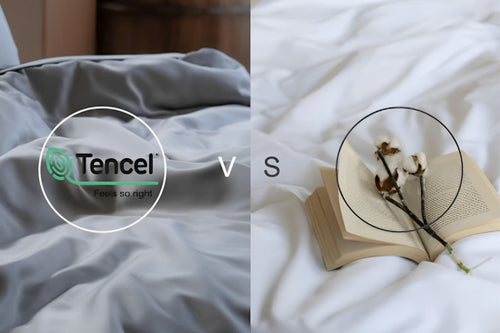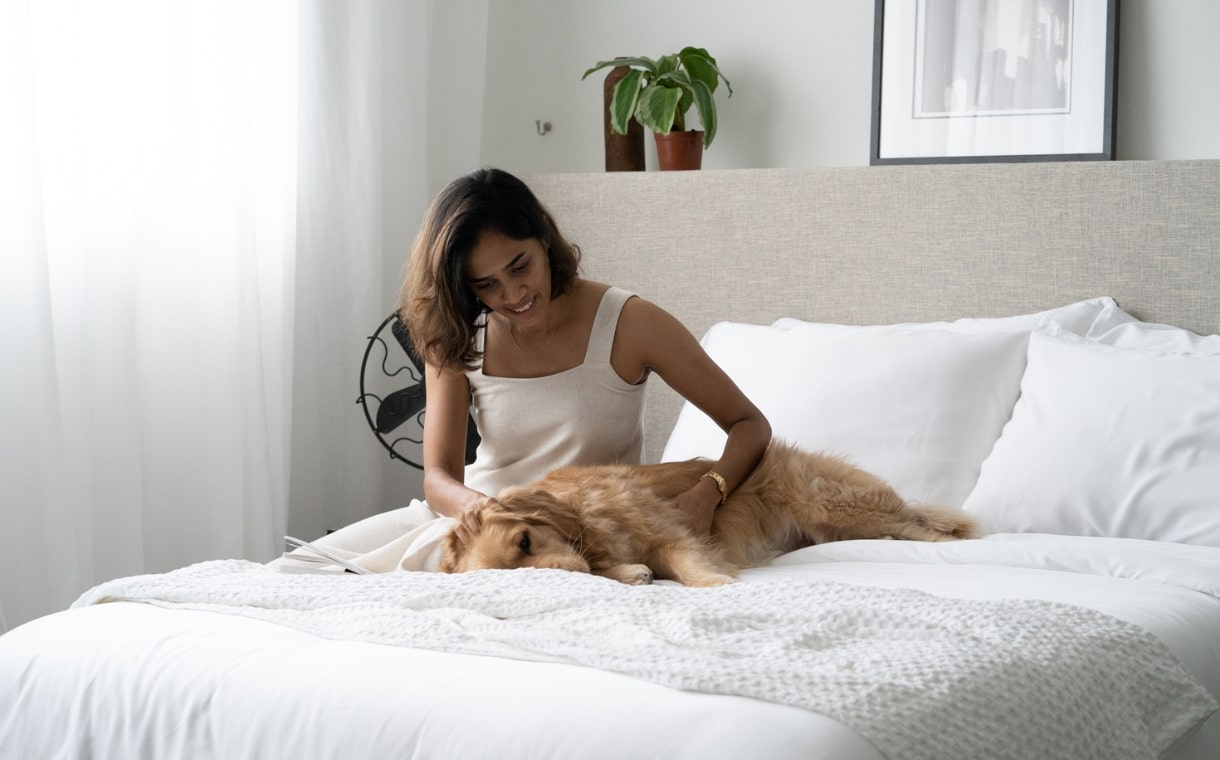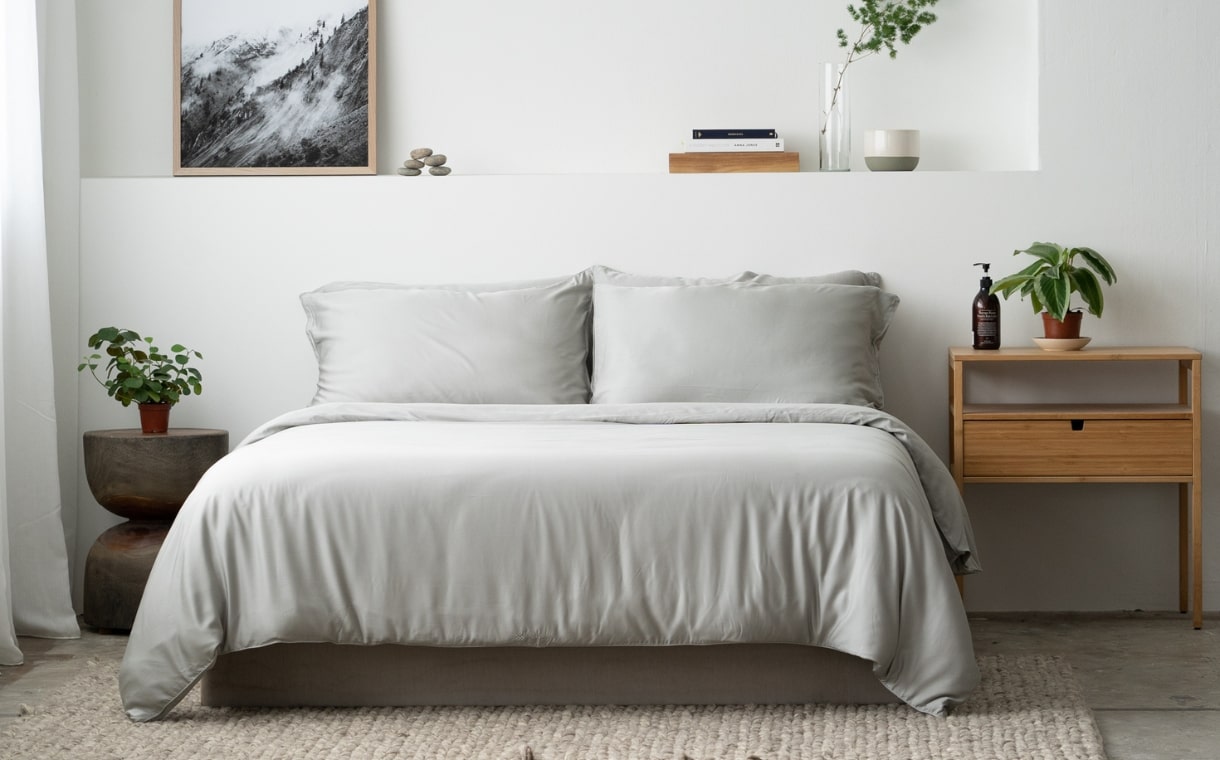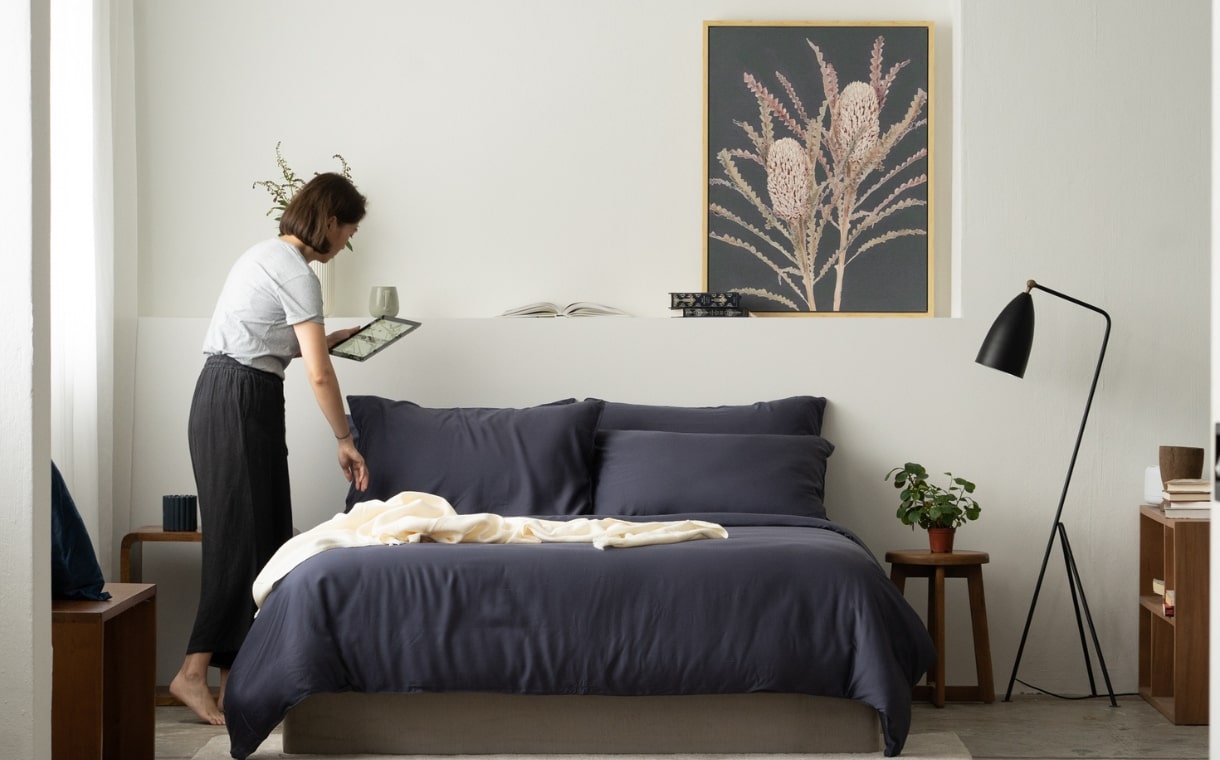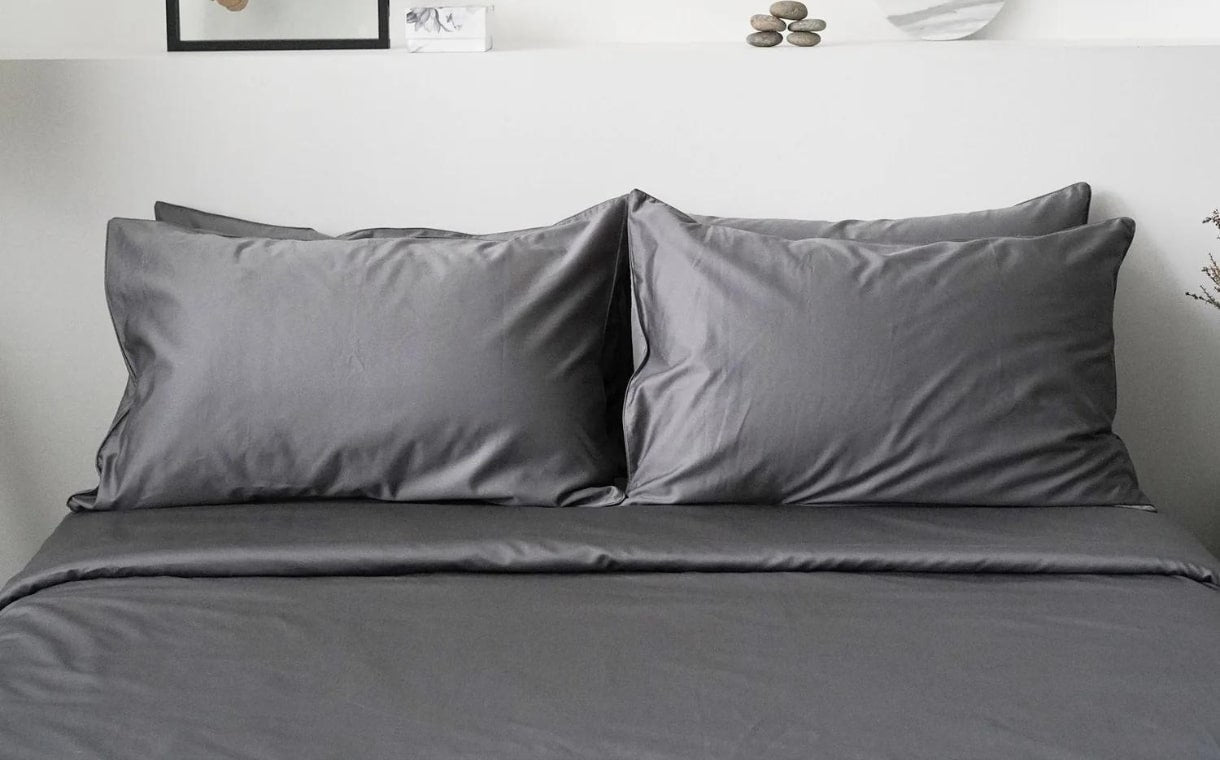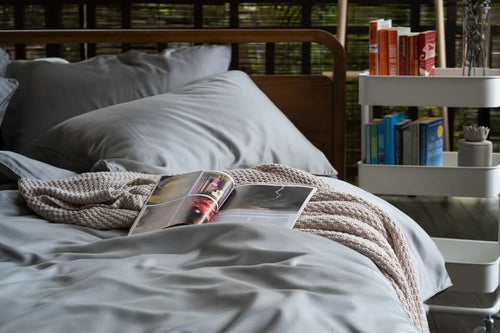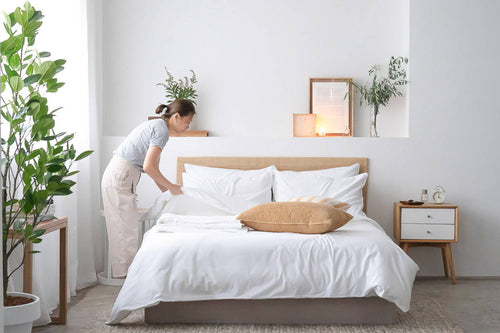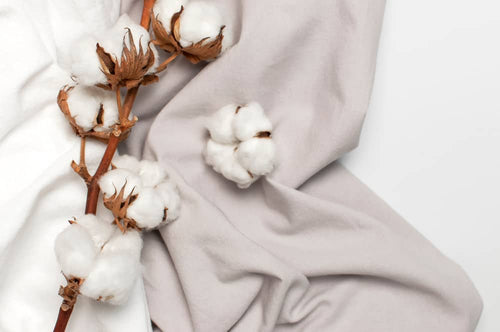At a Glance
Choosing the right bedsheet material is crucial for a restful night's sleep. Whether you opt for the popular cotton or the eco-friendly TENCEL™, this guide will help you make an informed decision.
Quick Tips
- Know the different variants of cotton and TENCEL™.
- Consider the material's resistance to pilling.
- Look for pure fibres as blends may not give the best quality.
Considering that we spend a third of our lives sleeping, a good night’s rest is essential to our overall health and well-being. It only makes sense to pick perfect bedding sets that create a relaxing bedroom environment. In fact, your bedding can make or break your sleep quality at night - whether you sleep soundly or toss and turn through the night.
Bed sheets in Singapore come in a wide range of sizes, shapes, and materials. These could potentially make choosing bedsheets overwhelming. As cotton retains first as the world’s most common bed sheet material, TENCEL™ fabrics have also been rising in popularity.
Researching and buying bed sheets online should not be a daunting task, and we are here to help you decide - whether TENCEL™ vs cotton. In this article, we detail their similarities, differences, and which one you should pick depending on your preferences.
Featuring Weavve's Signature TENCEL™Classic Set in Cloud White
Table Of Contents
| TENCEL™ Vs Cotton | |
| What Is TENCEL™? | |
| Why TENCEL™? | |
|
What Is Cotton? |
|
|
Why Cotton? |
TENCEL™ Vs Cotton
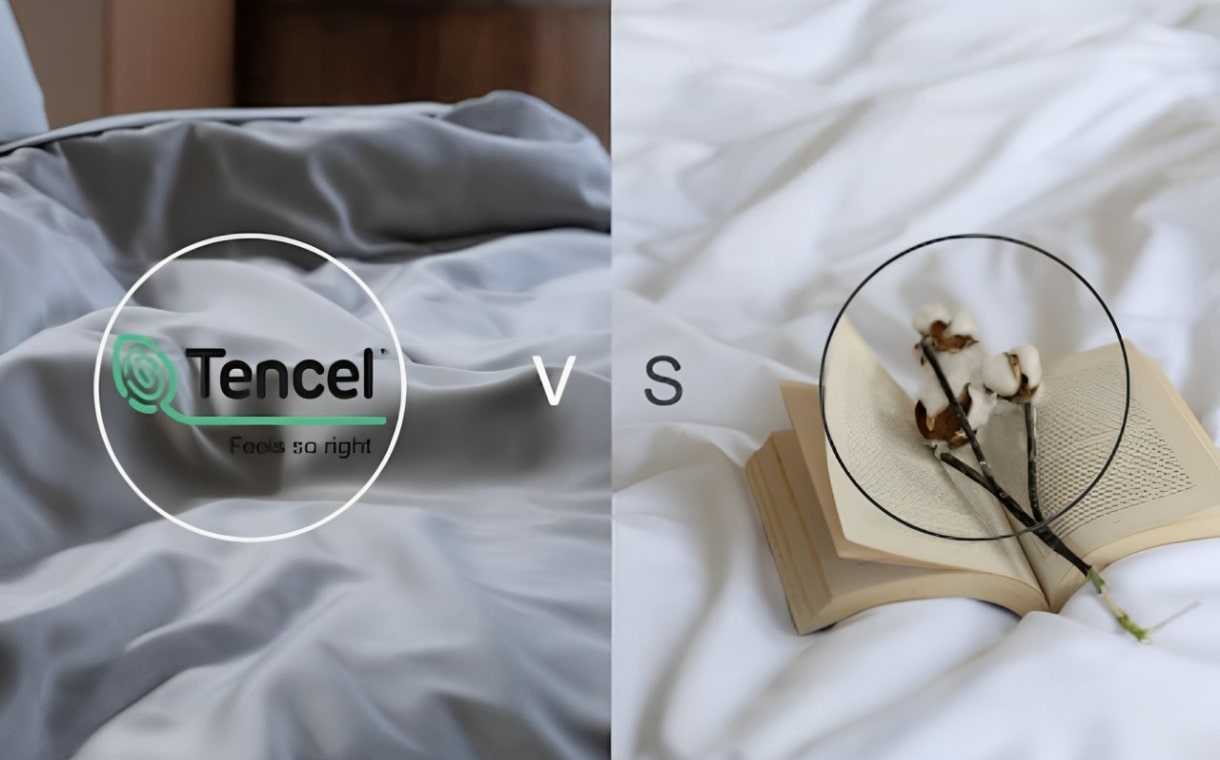
| Differences | TENCEL™ Lyocell | Cotton |
| Plant | Sourced from Eucalyptus wood harvested from natural forests and sustainably-managed tree farms | Cotton plants |
| Feel | Smooth, soft, and silky from the first day of use |
Smooth and even feel, higher quality cotton gets softer with every wash |
|
Cooling
|
Superior cooling sheets Breathable and moisture-wicking, excellent for regulating temperature in various climates |
Smooth and even feel, gets softer with every wash |
|
Aesthetic |
Smoother and drape, silk-like look
|
Crisp, matte look for percale weave and soft, subtle shine for sateen weave |
|
Suitability for sensitive skin |
Hypoallergenic and antibacterial |
Generally non-irritating on the skin |
|
Durability |
Resistant to wear and tear
|
Depending on the staple length - the longer the fibre, the more durable |
|
Wrinkle resistance |
More wrinkle-resistant |
Not wrinkle-resistant |
|
Shrinkage |
Less likely to shrink |
Shrinks more than TENCEL™ fibres, depending on the type of cotton |
|
Sustainability |
Needs less energy and water to produce |
Requires more energy and water to produce
|
|
Care |
Relatively easy to maintain |
Easy to care for |
|
Cost |
Generally higher price point than cotton due to more expensive production methods |
Different price points available, from more budget-friendly to luxury options depending on the type of cotton |
Image By Andrea Piacquadio From Pexels
What Is TENCEL™?
Produced by Austrian textile company Lenzing AG, TENCEL™ is the brand name for semi-synthetic fibres such as Modal and Lyocell, two fabrics commonly used in bedding and clothing. When comparing TENCEL™ Modal vs cotton, the differences are almost similar with Lyocell. However, TENCEL™ Lyocell is stronger and has more moisture-wicking properties.
Lenzing’s core market is wood-based cellulose fibres. They manufacture Viscose, Modal, self-sufficient biorefineries and closed-loop production to being actively involved in the protection of endangered and primeval forests, it is clear that TENCEL™ fabrics are not only ethically produced but also eco-friendly all at the same time.
Types Of TENCEL™
As previously mentioned, TENCEL™ is Lenzing's flagship brand for textiles made from a spectrum of fibres, including Viscose and Lyocell. Although all of the fibres come from natural, renewable, and biodegradable sources, it could be challenging to differentiate them.

|
TYPES OF TENCEL™ FIBRES |
TENCEL™ VISCOSE |
TENCEL™ MODAL |
TENCEL™ MODAL |
|
Short Description |
LENZING™ ECOVERO™ Viscose fibres are derived from sustainable wood and pulp, coming from certified and controlled sources |
Modal is the second generation of regenerated cellulose fibres, and it was invented by Lenzing, who owns the patent on it TENCEL™ Modal is manufactured from sustainably managed beech wood supplied from Austria and neighbouring countries |
Made mainly of responsibly collected eucalyptus wood from natural forests and sustainably managed tree farms Eucalyptus trees grow quickly and require no hazardous chemicals or much water to survive |
|
Known For |
When compared to traditional viscose, LENZING™ ECOVERO™ branded fibres creates to 50% less emissions and water during production |
Stronger, finer, lighter, and more flexible than Viscose |
TENCEL™ Lyocell fibres have greater strength, effective moisture absorption, and skin softness due to a more consistent interior structure |
|
Things To Note |
Traditional Viscose fibre manufacturing is a chemical-intensive process that is frequently uncontrolled, resulting in harmful emissions and contamination |
They can also be combined with other fibres to increase softness and comfort |
Water and more than 99% of the chemicals used in the production process are recycled, making this the most environmentally friendly of all cellulose regenerated fibres |
TENCEL™ fibres may be blended with other fibres such as cotton or bamboo to make textiles such as bamboo lyocell. To hold the TENCEL™ brand and Lenzing TENCEL™ certification, a product just has to include 30% Lenzing fibres - therefore make sure the product you're buying is pure or merely a blend!
Blends are typically used to improve the fabric's feel, performance, or durability. Blends of TENCEL™ fibres, on the other hand, often do not preserve the greatest qualities of each material, so going pure is always preferable.
Image From TENCEL™
Future Of TENCEL™
TENCEL™ has come a long way since they started production and are still constantly thinking of new ways to improve and innovate through technology. Their latest innovation - REFIBRA™, advances the goals of designers and consumers who are increasingly interested in low impact options.
REFIBRA™ technology involves upcycling cotton scraps from garment production and transforming them into brand new cellulosic fibre materials for clothing and home products. It gives a second life to what would have otherwise been sent to landfills or incinerated.
REFIBRA™ is Lenzing’s first step in contributing towards the emerging circular economy of the future in the textile industry and further improves supply-chain transparency.
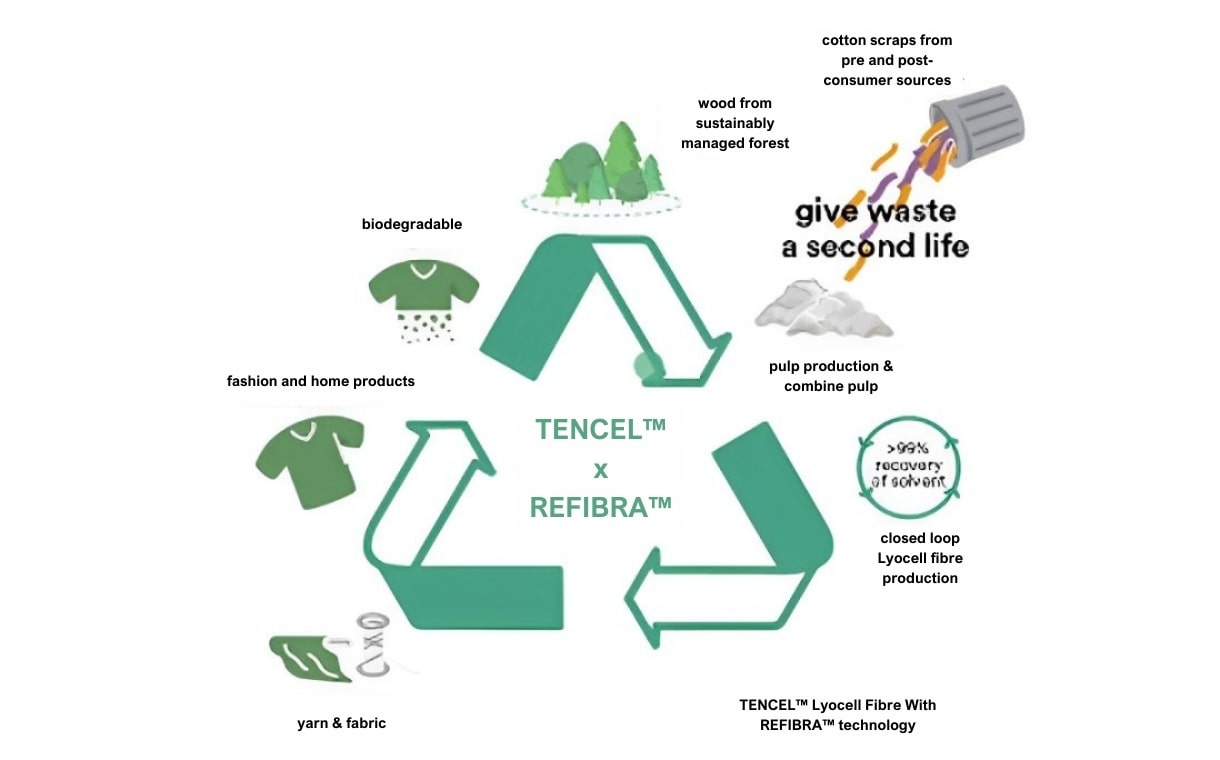
Image From TENCEL™ REFIBRA™
Why TENCEL™?
Cooling
If you are someone who is prone to sweating in your sleep and struggles to find sheets to keep you cool throughout the night, then TENCEL™ sheets may be the thing for you. With exceptional thermoregulating and breathable properties, TENCEL™ bedding sheets have been proven to feel cooler to the touch.
In fact, this ‘cooling feeling’ increases with increasing air humidity - perfect for Singapore’s weather conditions! This temperature-regulating textile will keep you cool and dry in bed, allowing you to achieve a good night’s sleep anywhere, at any time.
Gentle On The Skin
Believe it or not, one of the biggest triggers of acne is the type of sheets you are sleeping on, especially spending approximately 8 hours a night lying in your sheets. As you sleep, your body expels heat which activates your sweat glands. This encourages the production of more sebum which leads to acne breakouts or itching on the skin.
Hence, TENCEL™ 's moisture-wicking abilities makes it the best sheets for people with sensitive skin or skin disorders, such as eczema or psoriasis. They are less likely to attract dust mites and slow down bacteria growth by 10 times as compared to cotton. The natural materials used in the production of TENCEL™ fibres have resulted in this hypoallergenic quality.
Luxurious Look
Bed sheets are an easy yet impactful way of giving a bedroom personality. Dread ironing your sheets? With their natural silky look and resistance to wrinkles, TENCEL™ bed sheets automatically give a bed a luxurious finish effortlessly with a silk-like drape. They are also more vibrant and shine radiantly as it retains dye better and are less prone to fading over time.
Moreover, they are relatively easy to care for despite having slightly more restrictions when it comes to cleaning. Hand washing is preferred but they are also machine washable on a delicate cycle with cold-water temperature.
Eco-Friendly Option
In a recent study done by market research firm YouGov shows that more than half of Singapore consumers believe that firms should ensure that their supply chains do no harm to the environment. If you fall into this category of consumers, you may consider exploring TENCEL™ fibre sheets.
Production of TENCEL™ fibres is undeniably more environmentally friendly than other fibres as it involves a closed-loop process that recycles more than 99% of the solvent used in manufacturing. It also uses less water and energy than conventional cotton production.
Apart from minimal waste and better water conservation, TENCEL™ itself supports verified climate protection projects, specifically in communities impacted by the textile industry. These projects aim to help ill-prepared communities become more climate-resilient and introduce them to new sources of renewable energy. For example, improved cookstoves in Bangladesh, solar water heating in India and Kamphaeng Saen landfill gas to energy in Thailand.
This gives consumers who are all for sustainability a peace of mind knowing that they are supporting a brand that cares deeply about Mother Earth.

Image From TENCEL™
What Is Cotton?
Cotton is a natural fibre harvested from the cotton seed pod of cotton plants. It is the most widely used traditional material today - from drying our faces on a soft cotton towel in the morning, to putting on our favourite worn-in cotton t-shirt, until we slide between fresh cotton bed sheets at night, it is impossible to avoid cotton.
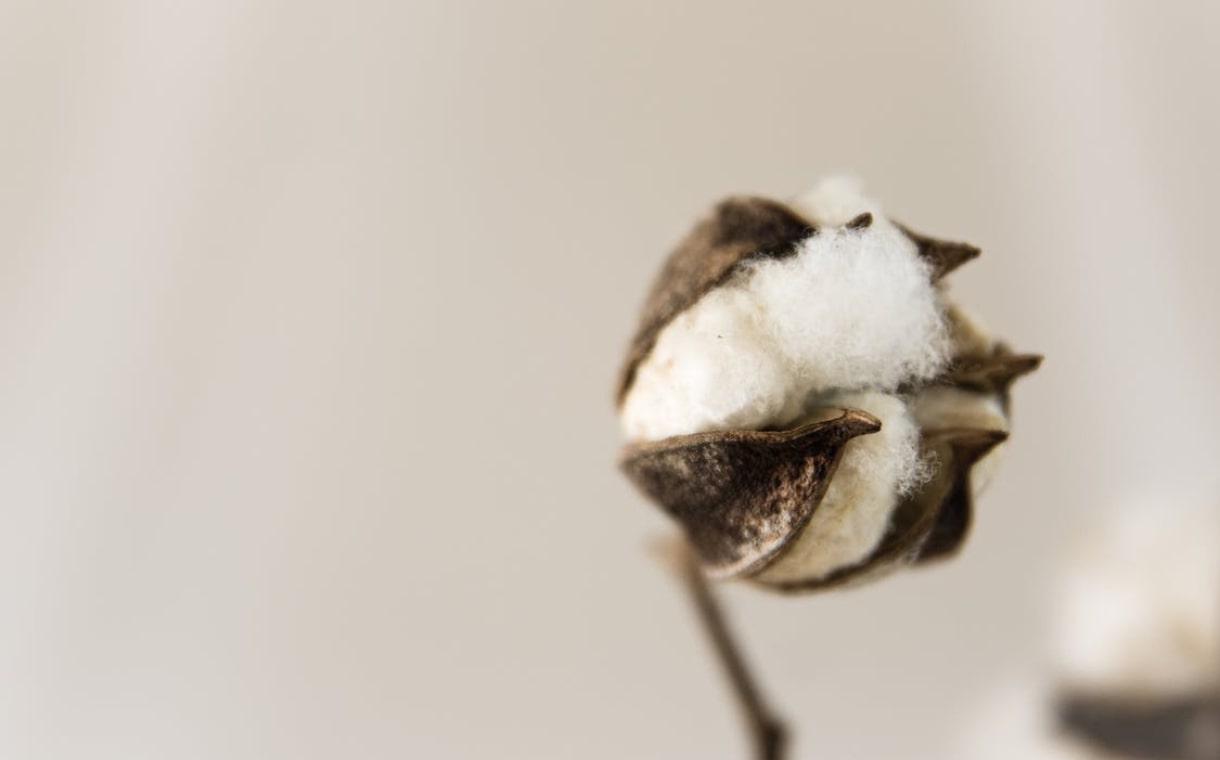
Image By Magda Ehlers From Pexels
The production of cotton fabric from cotton fibres these days requires a machine called Cotton Gin to remove the seeds from cotton bolls, as well as any dirt from the cotton. The raw cotton fibres are then transformed into long strands through a process called carding. These long strands are then spun into yarn and put through various chemical treatments to be dyed and finally woven into their designated textile material such as bed sheets or apparels.
It is no wonder that cotton is one of the most beloved and widely used fabrics in the world. It is a drought-resistant crop that occupies just 2.1% of the world’s arable land, yet meets 27% of the world’s textile needs. Traditionally, cotton has been associated with its fair share of social and environmental risks. However, the growing awareness about these drawbacks have prompted several worldwide initiatives to produce cotton more sustainably and equitably.
One of which being the 2025 Sustainable Cotton Challenge (2025 SCC), which aims to increase the percentage of world’s sustainable cotton from 22% to 50% by 2025. Programs like these help to regulate cotton production to allow consumers to feel more assured about consuming cotton products.
Types Of Cotton
Not all cotton is the same and the quality of fabric can be determined based on several factors - their staple length, thread count, weave, etc.
Staple length, also known as the length of the fibres, is one of the most important factors in determining the softness of cotton fabrics. Extra-long staple cotton fibres make sheets and fabric that are finer, smoother, and lighter.
Featuring Weavve's Cotton Deluxe Set In Cloud White
Thread count is defined as the total number of threads woven vertically (warp) and horizontally (weft) into one square inch of a fabric. Generally, it is understood that the higher the thread count, the softer and smoother the sheets. Thread count for sheets ranging from 400 - 600, when made with quality cotton fibres, is sufficient enough to create materials with a soft and luxurious finish.
In fact, what you hear and see on labels about thread count is usually a bedding myth! High thread count should not be the only key indicator when looking for quality sheets in Singapore. Knowing that the bedsheet thread count has a huge influence on consumers’ decisions, manufacturers may rely on heavy marketing and use misleading computations to manipulate their numbers.
The weave of a fabric is considered a design or construction of the yarn to achieve a particular pattern, which determines its texture, breathability, and durability. Two of the most common are sateen and percale weave. Opt for sateen cotton if you want a smooth hand feel with a sheen finish then percale cotton for a crisp, matte-like weave.
| TYPES OF COTTON BLENDS / WEAVES | PERCALE | SATEEN | TWILL |
| Short Description | Percale has a basic one thread over, one thread under pattern | Woven using a four over and one under weave pattern leaving more continuous thread surfaces exposed, leaving the fabric feeling luxurious and smooth, similar to silk | Twill has diagonal ribbing, just like denim |
| Properties |
Lightweight, crisp against the skin
|
Luxurious sheen and smooth feel and gets softer with each wash Sateen sheets may sometimes be prone to wrinkling during the wash, but generally more resistant to wrinkling than percale |
Relatively rougher texture |
At the end of the day, personal preference plays the biggest role in purchasing the best quality cotton bedding for yourself. Whether you’d prefer a warmer sheet to be snug and cosy or a cooling sheet to suit Singapore’s humid weather, we have compiled a brief description of the most common fabrics and weaves for you to make a better, well-formed choice when you buy cotton bed sheets.
| TYPES OF COTTON STAPLE | EXTRA-LONG STAPLE COTTON | LONG STAPLE COTTON | SHORT STAPLE COTTON |
| Short Description |
1 ⅜ inches to 2 inches long
|
At least 1 ¼ inches long High quality |
1 ⅛ inches long Lowest quality |
| Properties | Luxuriously soft and smooth, strong and most durable | Softer, stronger, and more durable | Rougher, strong, and durable |
| Examples | Gossypium Barbadense (Egyptian Cotton, Pima Cotton, Supima Cotton) | Gossypium Hirsutum (Upland Cotton) | Gossypium Arboreum (Muslin), Gossypium Herbaceum (Levant Cotton) |
When it comes to the various types of cotton, it is important to ensure that the type of cotton that the fabric claims to be from is verified or certified.
For example, cotton that is grown in Egypt, both long and short staple, can be technically labelled as Egyptian cotton which makes it hard to guarantee the quality of the ‘Egyptian cotton’ that you’re buying. And there are a lot of fabrics claiming to be Pima cotton that are actually just a blend of pima. Hence, look out for a verified Egyptian cotton, Pima cotton, or Supima cotton instead.
Future Of Cotton
Slowly but steadily, the demand for sustainable and eco-friendly fabric from consumers has increased. Thus, pushing for the cotton industry to reduce its environmental impacts through innovation for a more sustainable solution.
One such example is organic cotton. Grown without using harmful chemicals and pesticides, organic cotton poses as a viable alternative to traditional cotton. This chemical-free production reduces the negative impacts to the health of cotton farmers and locals. Moreover, organic cotton requires less water as compared to conventional cotton, which has a positive impact on water conservation at cotton plantations.
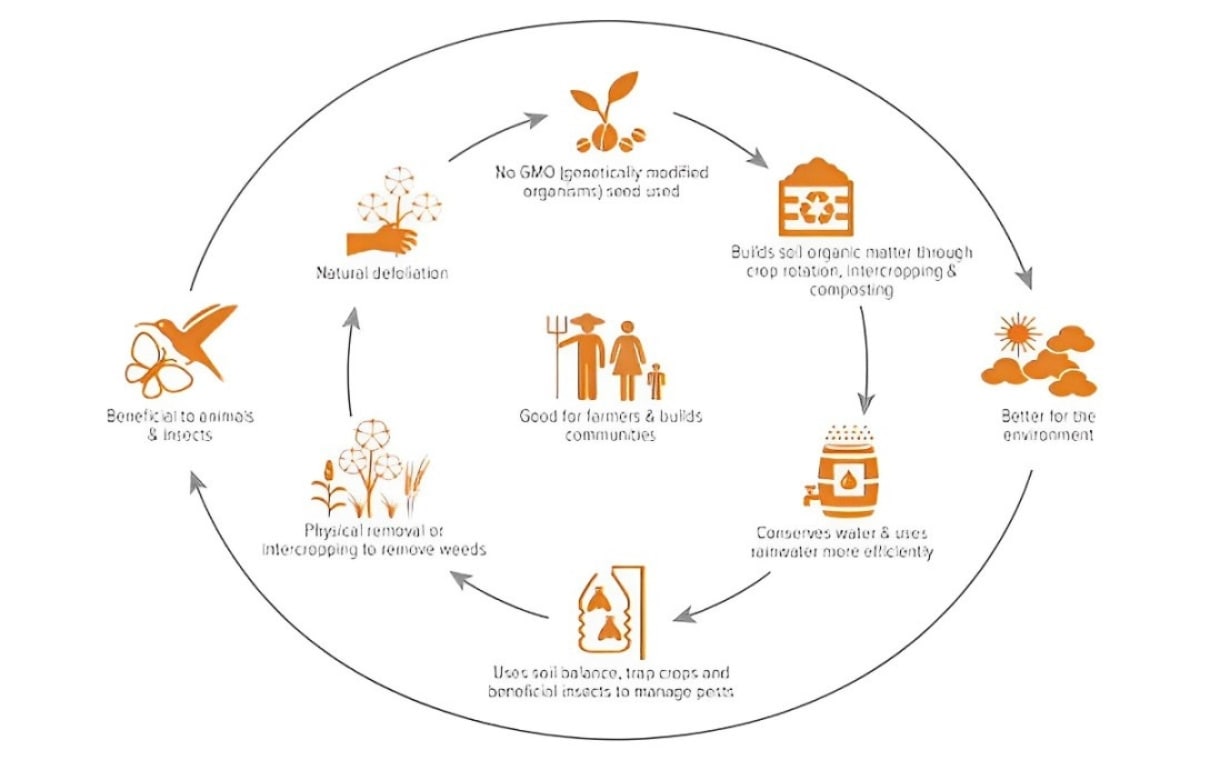
Image From aboutorganiccotton.org
However, organic cotton production is far from perfect. Organic cotton yields fewer fibres which requires more plants and ultimately more land to produce. It also requires a lot of processing and dying which are also chemically intensive. Thus is it important for consumers to be aware of greenwashing of brands who claim to use organic cotton without certification. Fibres that are grown organically but processed with harmful chemicals may still carry the organic label.
A certification you may want to look out for is the Standard 100 by Oeko-Tex® label, which tests every product component for harmful levels of over 100 individual substances from 17 groups of chemicals.
Why Cotton?
Breathable And Cosy
Cotton fibres are natural hollow fibres, known for their breathability and softness. If you are looking to slip under something cosy for a good night’s sleep, cotton may be the material for you.
Increased Softness With Every Wash
Sometimes cotton bed sheets may feel scratchy or overly crisp at the start of its use, however, rest assured that this is not forever. Cotton bed sheets generally get softer with each wash, thus the longer you use them, the more comfy they feel.
Low Maintenance
Unlike TENCEL™ fibre sheets, cotton sheets are able to sustain higher temperatures of washing and drying, making them easy to wash and care for.
More Affordable
When it comes to weighing the budget between TENCEL™ or Egyptian cotton, the gap may make a difference. But that still depends on the cotton variant, among other factors. With a wide variety of cotton types and blends, there is surely something for everyone at different price points. If TENCEL™ or bamboo bed sheets are out of the budget, quality cotton bed sheets are just a good option for luxury comfort. They, too, have a soft touch to the skin and do the job of keeping you cosy at night, without having to empty your wallet.
Ultimately your personal preference plays the biggest role in purchasing the best bedding material for yourself. From your lifestyle to sleeping style and your views about sustainability, there could be an argument made between TENCEL™ vs cotton bed sheet sets.
Frequently Asked Questions: TENCEL™ Vs Cotton
What is the difference between TENCEL™ and cotton?
TENCEL™ and cotton have different fibres, which can affect how the material feels. Both are prized for their breathability, durability and softness. Here is a summary of their differences.
TENCEL™ Lyocell is ethically sourced from eucalyptus wood. To produce this material, wood pulps are dissolved in a solvent and extruded through small holes to make fibres. The resulting fibres are then treated and spun into yarn.
Meanwhile, cotton is sourced from cotton plants. The production of cotton fabric from cotton fibres these days requires a machine called Cotton Gin to remove the seeds from cotton bolls, as well as any dirt from the cotton. The raw cotton fibres are then transformed into long strands through a process called carding. These long strands are then spun into yarn and put through various chemical treatments to be dyed and finally woven into their designated textile material such as bed sheets or apparels.
In terms of breathability, TENCEL™ Lyocell and cotton are both great options, though TENCEL™ Lyocell will be a better candidate. The Lyocell fibres have excellent moisture-wicking properties that keep users cool and dry throughout. For those with sensitive skin and need something gentle, TENCEL™’s smooth surface and good temperature regulation will make it a better choice than cotton.
As for durability, TENCEL™ Lyocell is more resistant to wear and tear and pilling than cotton. Cotton sheets are also durable, depending on its staple length and quality of cotton used - the longer the fibre, the more durable it is.
TENCEL™ fabric tends to feel softer than cotton, though both feel smooth to the touch. TENCEL™ Lyocell has an incredibly silky and cool feel from the first day of use. Cotton sheets may feel scratchy or overly crisp at the start of its use, but gets softer with every wash.
Lastly, the production of TENCEL™ Lyocell fibres is undeniably more environmentally friendly than other fibres as it involves a closed-loop process that recycles more than 99% of the solvent used in manufacturing. It also uses less water and energy than conventional cotton production.
Is TENCEL™ better than cotton?
At the end of the day, personal preference plays the biggest role in purchasing the best bedding material for yourself. From your lifestyle to sleeping style and your views about sustainability, there could be opposing views regarding the different fabrics.
TENCEL™ is better than cotton for people who:
- are hot sleepers
- have sensitive skin
- likes the sustainable and eco-friendly production of TENCEL™ fibres
- looking for a fabric that shares the texture of silk and feels cooler than linen
Cotton is better than TENCEL™ for people who:
- like to be cosy in bed and the snug feel of a crisp cotton shirt
- want their sheets to get softer with each wash looking for sheets that get softer with every wash
- looking for a sumptuous, smooth feel without the drape-like look of silk
- need breathable bed sheets that can hold up
What is the best material for hot sleepers?
Both TENCEL™ fibre and cotton sheets are good options for hot sleepers as they are cooling. However, TENCEL™ fibre bed sheet is the best choice for hot sleepers because of its moisture-wicking properties. This allows for better thermoregulation especially in high humidity such as Singapore’s weather condition.
Is TENCEL™ a breathable fabric?
One of TENCEL™ fibre's greatest strengths is that they have exceptional thermoregulating and breathable properties. This microfibre makes TENCEL™ bedding sheets feel cooler to the touch. In fact, this ‘cooling feeling’ increases with increasing air humidity - perfect for Singapore’s weather conditions! This temperature regulating textile will keep you cool and dry in bed, allowing you to achieve a good night’s sleep anywhere, at any time.
Is TENCEL™ more breathable than cotton?
What gives a fabric its breathability is the size of their fibres. Cotton fibres are hollow whereas TENCEL™ Lyocell fibres are nano-fibrils - extremely small fibres. Hence, making TENCEL™ moisture-wicking, allowing sweat to evaporate more efficiently from your skin rather than sticking to it.
So in short, yes, TENCEL™ is more breathable than cotton.
Does TENCEL™ shrink like cotton?
Even though TENCEL™ fibre fabrics require slightly more delicate care during wash, they are resistant to shrinking. Cotton sheets on the other hand, may shrink with each wash, depending on the type of cotton used.
Is TENCEL™ biodegradable?
TENCEL™ Lyocell and Modal fibres have been certified by the Belgian certification company Vinçotte as biodegradable and compostable under industrial, home, soil, and marine conditions. Thus after their natural lifespan, they can fully revert back to nature.































